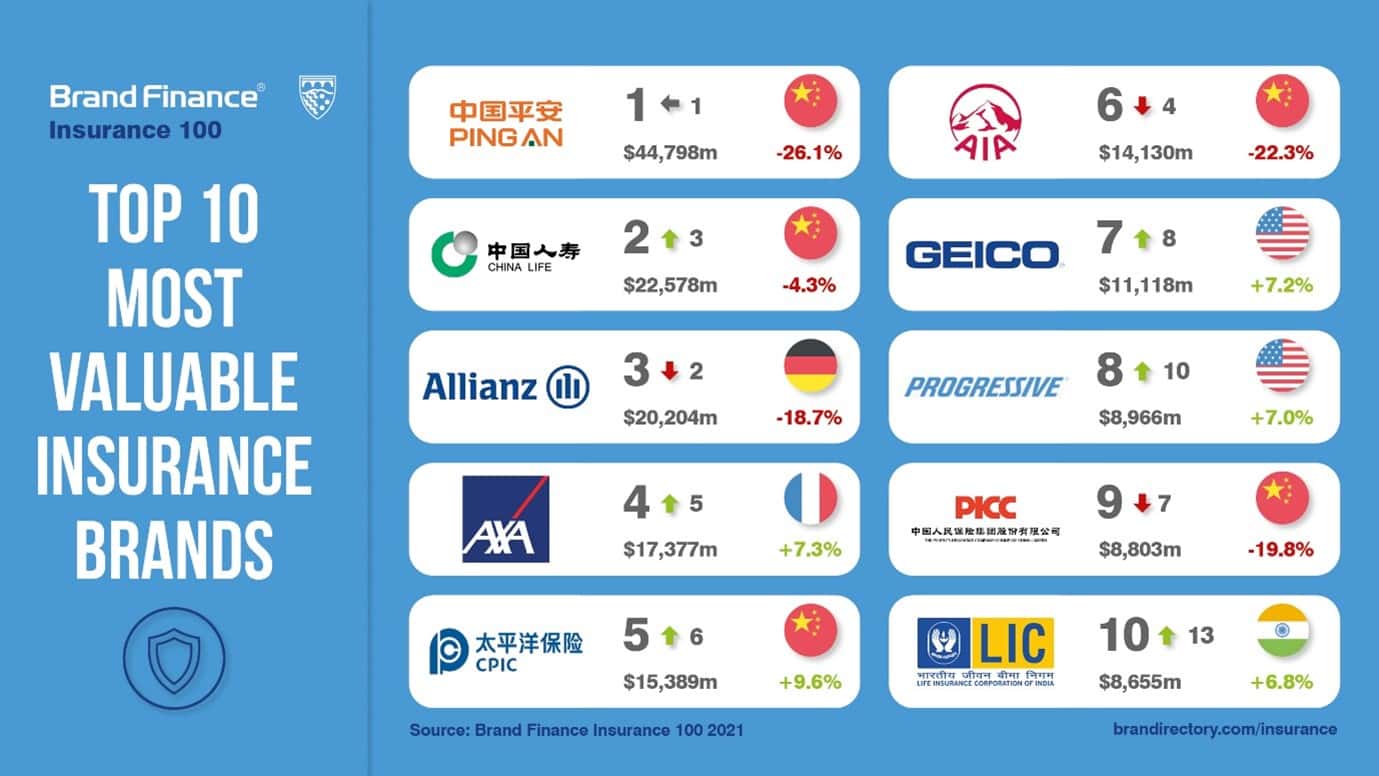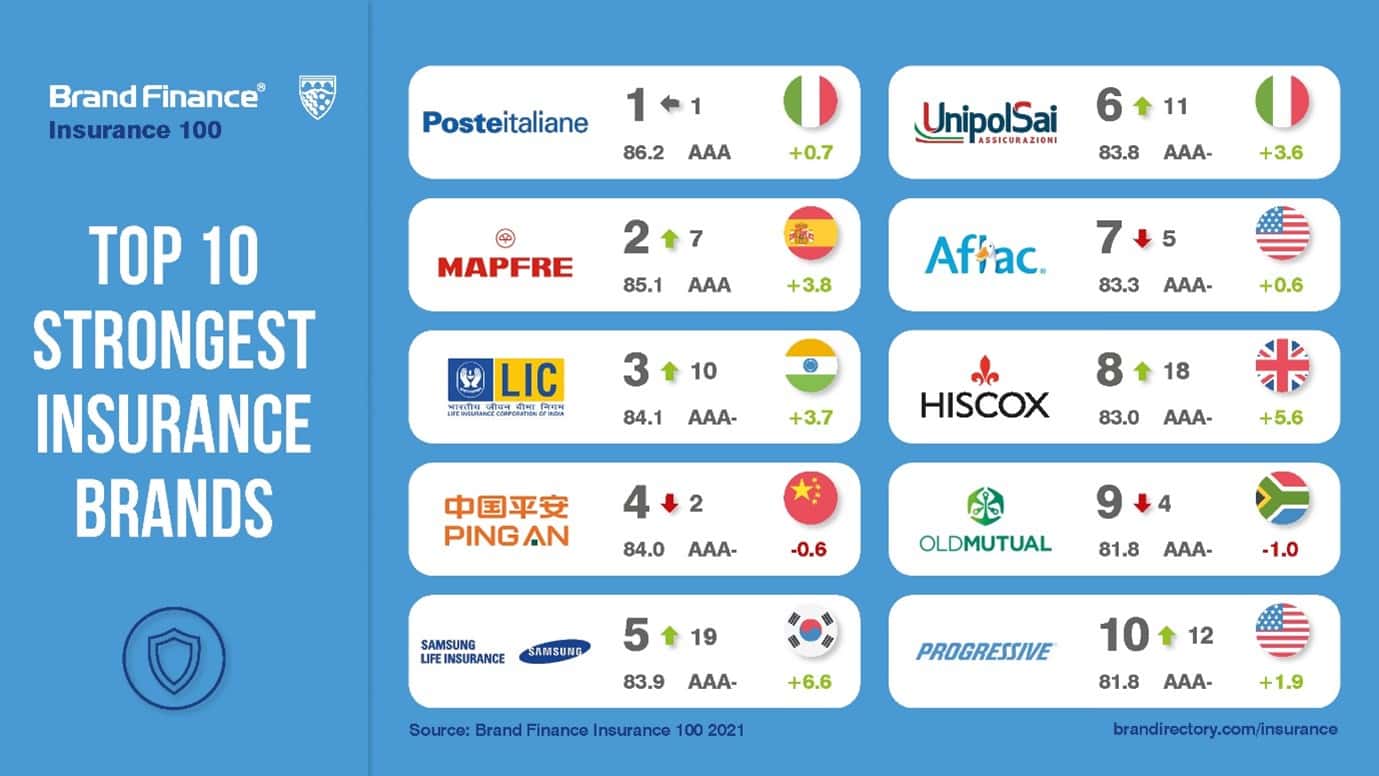View the full Brand Finance Insurance 100 2021 report here
The total value of the world’s top 100 most valuable insurance brands has declined by 6%, decreasing from US$462.4 billion in 2020 to US$433.0 billion in 2021, according to the Brand Finance Insurance 100 2021 report.
Declan Ahern, Director, Brand Finance, commented:
“As predicted, insurance brands have taken a hit this year as they negotiate the fallout from the pandemic – from the near standstill of the global economy and prolonged low interest rates to slowing development across the sector in general. They have, however, fared better than our initial predictions at the outbreak of last year, demonstrating the resilience of the world’s top insurance brands.”
Ping An continues to lead field
Ping An is still by far the world’s most valuable insurance brand, despite recording a 26% drop in brand value to US$44.8 billion. The decline in brand value is largely attributable to the temporary drop in future earnings and revenue outlook, compared to the previous year. The brand has, however, already begun to show signs of a strong recovery as parts of the world begin to remerge from the pandemic, and therefore, if this trend continues, Ping An should see a solid increase in brand value in the coming year.
Ping An has continued to reap the benefits of its Good Doctor app - the world's leading online healthcare platform – which posted growth in both revenue and user traffic over the last year. The app has proved central to helping combat the repercussions of the pandemic through increasing the speed of diagnoses as well as through providing faster treatment services.
China Life overtakes Allianz
China Life has overtaken Allianz (down 19% to US$20.2 billion) to claim second spot in the Brand Finance Insurance 100 2021 ranking, after recoding a slight 4% decrease in brand value to US$22.6 billion.
Three further Chinese brands feature in the top 10: CPIC (up 10% to US$15.4 billion) in 5th; AIA (down 22% to US$14.1 billion) in 6th; and PICC (down 20% to US$8.8 billion) in 9th. Overall, there are 12 Chinese brands featured in the ranking, with their cumulative brand value accounting for 30% of the total brand value. With access to a market as immense as China, this offers these brands huge potential to leverage a significant volume premium over many other markets.
CPIC is once again the fastest growing brand in the top 10, following a 10% brand value increase to US$15.3 billion. The brand has continued to focus on expansion into new markets and has been implementing its plans to onboard high-quality investors globally by making its debut on the London Stock Exchange as part of the London-Shanghai Stock connect scheme.

US brands buck trend
On the whole, US insurance brands have fared well compared to their international counterparts, with the 26 brands hailing from the nation recording a cumulative brand value growth of 14% year-on-year. Brand Finance’s research from the Global Brand Equity Monitor study shows that the majority of US insurers performed well throughout the pandemic, with consumers exhibiting high levels of brand equity. The pandemic forced many Americans to think about insurance – perhaps for the first time - and interact with health insurers, thus increasing overall demand and awareness. The two US insurance brands in the top 10 – GEICO and Progressive –have bothrecorded a 7% uplift in brand value.
The US is also home to the fastest growing brand in the ranking - Jackson National Life Insurance Company – which has seen an impressive 43% brand value increase to US$3.6 billion. Jackson celebrated solid financial results last year and strives towards developing its suite of products, as well as expanding its footprint. With the recent announcement that its parent company, Prudential (down 26% to US$5.0 billion), plans to separate Jackson, through demerger distribution, the impact on it brand value in the coming year will depend on how well the brand establishes its position in the market and how it implements its strategy as a single entity.
Poste Italiane is sector’s strongest
In addition to measuring overall brand value, Brand Finance also determines the relative strength of brands through a balanced scorecard of metrics evaluating marketing investment, stakeholder equity, and business performance. According to these criteria, Poste Italiane (down 7% to US$6.2 billion) is once again the world’s strongest insurance brand, with a Brand Strength Index (BSI) score of 86.2 out of 100 and a corresponding AAA brand strength rating.
The ability of the brand to succeed and thrive in areas that are unrelated to its core business model showcases just how strong the Poste Italiane brand is. In addition to insurance services, Poste has three other business units: mail; payments and financial services; and over 12,000 post offices located across the country, which act as bank and insurance branches. Poste is also active in mobile and fixed line internet services, and last year announced its entry into the fibre space thanks to its partnership with TIM and OpenFiber.
The crucial role that Poste has played in the digital landscape across the nation has been even more vital throughout the turbulence of the previous year. The main Italian regions have been using the Poste portal to manage Covid vaccinations reservations after the services of local administrations proved inefficient – showcasing the brand’s ability to leverage its strength and demonstrate that they can deliver value to the community in a moment of great need.

View the full Brand Finance Insurance 100 2021 report here
Note to Editors
Every year, Brand Finance puts 5,000 of the biggest brands to the test, evaluating their strength and quantifying their value, and publishes nearly 100 reports, ranking brands across all sectors and countries. The world’s top 100 most valuable insurance brands are included in the Brand Finance Insurance 100 2021 report.
The full Brand Finance Insurance 150 2021 ranking, additional insights, charts, more information about the methodology, as well as definitions of key terms are available in the Brand Finance Insurance 100 2021 report.
Brand value is understood as the net economic benefit that a brand owner would achieve by licensing the brand in the open market. Brand strength is the efficacy of a brand’s performance on intangible measures relative to its competitors. Please see below for a full explanation of our methodology.
About Brand Finance
Brand Finance is the world’s leading brand valuation consultancy. Bridging the gap between marketing and finance, Brand Finance evaluates the strength of brands and quantifies their financial value to help organisations of all kinds make strategic decisions.
Headquartered in London, Brand Finance has offices in over 20 countries, offering services on all continents. Every year, Brand Finance conducts more than 5,000 brand valuations, supported by original market research, and publishes nearly 100 reports which rank brands across all sectors and countries.
Brand Finance is a regulated accountancy firm, leading the standardisation of the brand valuation industry. Brand Finance was the first to be certified by independent auditors as compliant with both ISO 10668 and ISO 20671, and has received the official endorsement of the Marketing Accountability Standards Board (MASB) in the United States.
Methodology
Definition of Brand
Brand is defined as a marketing-related intangible asset including, but not limited to, names, terms, signs, symbols, logos, and designs, intended to identify goods, services, or entities, creating distinctive images and associations in the minds of stakeholders, thereby generating economic benefits.
Brand Value
Brand value refers to the present value of earnings specifically related to brand reputation. Organisations own and control these earnings by owning trademark rights.
All brand valuation methodologies are essentially trying to identify this, although the approach and assumptions differ. As a result, published brand values can be different.
These differences are similar to the way equity analysts provide business valuations that are different to one another. The only way you find out the “real” value is by looking at what people really pay.
As a result, Brand Finance always incorporates a review of what users of brands actually pay for the use of brands in the form of brand royalty agreements, which are found in more or less every sector in the world.
This is known as the “Royalty Relief” methodology and is by far the most widely used approach for brand valuations since it is grounded in reality.
It is the basis for our public rankings but we always augment it with a real understanding of people’s perceptions and their effects on demand – from our database of market research on over 3000 brands in over 30 markets.
Brand Valuation Methodology
For our rankings, Brand Finance uses the simplest method possible to help readers understand, gain trust in, and actively use brand valuations.
Brand Finance calculates the values of brands in its rankings using the Royalty Relief approach – a brand valuation method compliant with the industry standards set in ISO 10668.
Our Brand Strength Index assessment, a balanced scorecard of brand-related measures, is also compliant with international standards (ISO 20671) and operates as a predictive tool of future brand value changes and a control panel to help business improving marketing.
We do this in the following four steps:
1. Brand Impact
We review what brands already pay in royalty agreements. This is augmented by an analysis of how brands impact profitability in the sector versus generic brands.
This results in a range of possible royalties that could be charged in the sector for brands (for example a range of 0% to 2% of revenue).
2. Brand Strength
We adjust the rate higher or lower for brands by analysing Brand Strength. We analyse brand strength by looking at three core pillars: “Investment” which are activities supporting the future strength of the brand; “Equity” which are real perceptions sourced from our original market research and other data partners; “Performance” which are brand-related measures of business results, such as market share.
Each brand is assigned a Brand Strength Index (BSI) score out of 100, which feeds into the brand value calculation. Based on the score, each brand is assigned a corresponding Brand Rating up to AAA+, in a format similar to a credit rating.
3. Brand Impact x Brand Strength
The BSI score is applied to the royalty range to arrive at a royalty rate. For example, if the royalty range in a sector is 0-5% and a brand has a BSI score of 80 out of 100, then an appropriate royalty rate for the use of this brand in the given sector will be 4%.
4. Brand Value Calculation
We determine brand-specific revenues as a proportion of parent company revenues attributable to the brand in question and forecast those revenues by analysing historic revenues, equity analyst forecasts, and economic growth rates.
We then apply the royalty rate to the forecast revenues to derive brand revenues and apply the relevant valuation assumptions to arrive at a discounted, post-tax present value which equals the brand value.
Disclaimer
Brand Finance has produced this study with an independent and unbiased analysis. The values derived and opinions presented in this study are based on publicly available information and certain assumptions that Brand Finance used where such data was deficient or unclear. Brand Finance accepts no responsibility and will not be liable in the event that the publicly available information relied upon is subsequently found to be inaccurate. The opinions and financial analysis expressed in the study are not to be construed as providing investment or business advice. Brand Finance does not intend the study to be relied upon for any reason and excludes all liability to any body, government, or organisation.
The data presented in this study form part of Brand Finance's proprietary database, are provided for the benefit of the media, and are not to be used in part or in full for any commercial or technical purpose without written permission from Brand Finance.